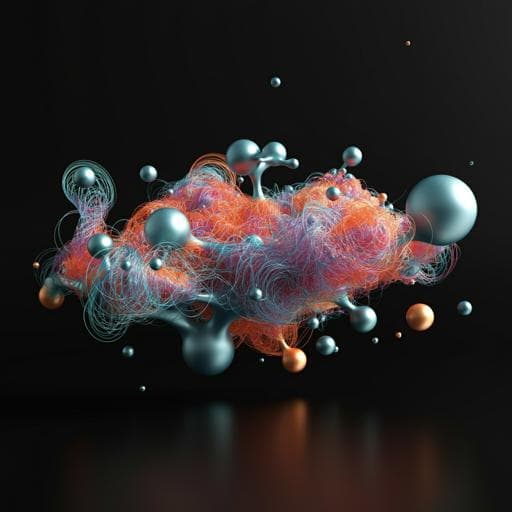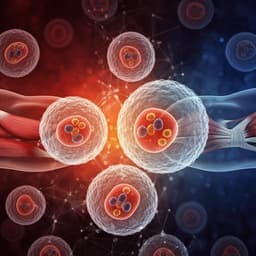
Physics
Approach and rotation of reconnecting topological defect lines in liquid crystal
Y. Zushi, C. D. Schimming, et al.
Explore the fascinating dynamics of topological defects in nematic liquid crystals as Yohei Zushi, Cody D. Schimming, and Kazumasa A. Takeuchi investigate disclination line reconnections. Discover how these defect lines interact, revealing a square-root law and intriguing discrepancies in mobility that challenge existing theories.
~3 min • Beginner • English
Introduction
The study addresses how three-dimensional nematic disclination lines reconnect when they approach each other at a finite angle while lying in different planes, a configuration that is intrinsically 3D and less explored than nearly parallel, in-plane reconnections. Building on the universality of topological defect dynamics across physical systems, the authors aim to quantify two observables during reconnection: the minimum distance δ(t) between the lines and the inter-line angle ψ(t) defined by their local tangents at the closest points. Prior work established square-root approach laws and symmetry restoration for in-plane events, but intersecting reconnections had not been quantitatively analyzed. The purpose is to experimentally measure δ(t) and ψ(t) in intersecting reconnections, test theoretical predictions for their coupled evolution, and resolve discrepancies by extending theory to unequal elastic constants and by conducting complementary Q-tensor simulations. The significance lies in advancing a fully 3D understanding of defect line dynamics relevant to liquid crystals and broadly to other systems with line-like topological defects.
Literature Review
Topological defects occur in diverse systems, including crystals, liquid crystals, superfluids, cosmology, and biological tissues. In nematics, disclinations have been widely explored for their creation, interactions (with colloids, light), manipulation, and control via boundary alignment. Many experimental observations relied on transmitted-light microscopy, providing only 2D projections. The authors’ previous work used fluorescent dye localization to visualize 3D disclination lines, revealing reconnections and loop shrinkage, but focused on approximately parallel, in-plane reconnections. Theoretically, while hydrodynamics and nematodynamics are well established, obtaining effective equations of motion for fully 3D disclination configurations is nontrivial. Recent theory and simulations (e.g., disclination density tensor, Q-tensor-based methods) have begun to predict scaling laws for line-line interactions and reconnection kinematics, suggesting a square-root distance law and coupled δ–ψ dynamics with a predicted equal mobility for distance and angle. However, these prior results generally assumed straight lines and often equal elastic constants, leaving open how anisotropy and line deformations affect observed mobilities.
Methodology
Experiment: A nematic liquid crystal (MLC-2037, Merck) with small optical anisotropy (Δn ≈ 0.0649) and negative dielectric anisotropy (Δε = −3.1) was doped with 0.01 wt% tetran-butylammonium bromide (to increase conductivity) and 0.005 wt% coumarin 545T (to label disclination cores). The sample was confined in a 130 µm-thick cell (ITO-coated coverslip and glass plate) with unidirectional planar alignment induced by polyvinyl alcohol rubbing. An AC voltage of 150 V rms at 35 Hz generated a dynamic scattering mode to create a high density of disclinations; upon switching off the voltage, disclinations relaxed, interacted, and annihilated. 3D imaging used a Leica SP8 laser-scanning confocal microscope (objective 40x, NA 1.30, oil). Excitation at 488 nm with polarization perpendicular to the easy axis; emission detected at 500–600 nm. Voxel size: 0.455 µm (xy), z-slice spacing 1 µm; volume 512 × 96 × 30 voxels; time interval 0.330 s. Twelve intersecting reconnection events were recorded, with both top and side views. Disclination coordinates were extracted from 3D intensity data using an active contour (snake) method that minimizes internal (length, smoothness) and image energy (intensity-based) with gradient descent; median and Gaussian filtering improved convergence (Appendix A). The reconnection time t0 was determined from higher time-resolution transmitted-light images. For each event, the minimum distance δ(t) and inter-line angle ψ(t) (defined at the closest points via local tangents) were measured. The analysis compared observed δ(t) and ψ(t) with theoretical relations, both as differential equations and in integrated forms to reduce noise.
Theory: To examine the role of elastic anisotropy, the authors generalized previous theory to unequal Frank constants with reduced twist (K2 < K1, K3). Starting from an elastic energy density with K1, K2, K3, they considered the director configuration around a line defect satisfying a linear anisotropic Laplace equation, yielding θ(x,z) = m arctan(x/(ε z)) with ε = √(K1/K2). They adopted a relaxational Q-tensor dynamics (∂t Q = −γ [∂F/∂Q]TS) with an elastic free energy including L1 and L2 terms mapped to K-constants. Assuming two infinitely long, straight disclinations with antiparallel rotation axes and neglecting hydrodynamic backflow, they derived equations for δ and ψ analogous to prior theory but allowing K2 ≠ K1 = K3. Under these assumptions, the predicted mobility ratio μ2/μ1 remains 1, independent of K2.
Simulations: 3D Q-tensor computations used the Maier–Saupe Ball–Majumdar bulk potential and the same elastic energy form, solved with the finite element package FELICITY and AGMG for linear solves. The system was non-dimensionalized by the nematic correlation length and relaxation time; fixed time step Δt = 0.2. Boundary equations were treated by solving the Euler–Lagrange equations for Q. Initial conditions comprised two straight line disclinations separated by δ0 = 4 along z and forming angle ψ0 about the y-axis, constructed from superpositions of the anisotropic director solutions; cos ψ0 ∈ {0.3, 0.4, 0.5, 0.6, 0.7, 0.8}. Two domain sizes were used: [Lx, Ly, Lz] = [10, 10, 10] and [20, 20, 10], with Lz/L⊥ = 2 (K2/K1 ≈ 0.5). During evolution, δ(t) and ψ(t) were measured; power-law relationships between sin ψ and δ and the δ ∝ √|t − t0| scaling were tested.
Key Findings
- Intersecting reconnections exhibit the square-root approach law: δ(t) ≈ C |t − t0|^{1/2} near t0, consistent with prior in-plane reconnections and theoretical expectations.
- The inter-line angle ψ decreases over time during approach; pairs tend to align more parallel as reconnection nears.
- Experimental δ and ψ obey coupled dynamics consistent with integrated forms of dδ/dt = −μ1 cos ψ and dψ/dt = −μ2 sin ψ. However, the effective mobility coefficients differ: the mobility ratio μ2/μ1 is significantly less than 1.
- From 12 intersecting reconnection events, the power-law relation sin ψ ∝ δ^{μ2/μ1} holds with an average exponent μ2/μ1 = 0.26 ± 0.08 (standard deviation). Direct fittings of the integrated equations yield consistent μ1, μ2 values and ratios.
- Extended theory including reduced twist elasticity (K2 < K1 = K3; for MLC-2037, K2 ≈ 6.1 ± 0.5 pN, K1 ≈ 11.6 pN, K3 ≈ 13.2 pN) still predicts μ2/μ1 = 1 under the assumptions of straight lines and relaxational dynamics, failing to explain the observed μ2/μ1 ≈ 0.26.
- Experimental correlation: μ2/μ1 shows a slight negative correlation with the initial angle between disclinations—larger initial angles tend to yield smaller μ2/μ1—indicating rotation slows relative to approach when lines are more oblique.
- Simulations (anisotropic elasticity, no hydrodynamics): confirm δ ∝ √|t − t0| (especially for larger systems) and a power-law sin ψ–δ relation for non-overlapping cores (δ ≥ 2). For smaller systems, μ2/μ1 ≈ 0.9; for larger systems (longer lines), μ2/μ1 decreases and drops with increasing initial angle, qualitatively matching experiments.
- Overall, results point to disclination line deformations during reconnection as the likely mechanism reducing rotational mobility relative to approach, especially for longer lines and larger mutual angles.
Discussion
The experimental observation that δ follows a square-root law and ψ decreases corroborates the qualitative predictions of recent 3D disclination theories and simulations, supporting the universality of approach dynamics. However, the pronounced quantitative discrepancy in the mobility ratio (μ2/μ1 ≈ 0.26 experimentally vs 1 predicted) indicates missing physics in theories assuming straight lines and local kinematics. Accounting for unequal elastic constants (reduced twist) within the straight-line approximation does not alter the predicted ratio, pointing away from elastic anisotropy alone as the cause. Experimental correlations and simulation trends both implicate geometrical deformations of the disclination lines during reconnection: as lines rotate to reduce ψ, they undergo local/global bending and twist that likely introduce additional drag or redistribute driving forces, preferentially slowing rotational alignment compared to translational approach. The effect strengthens with longer line length and larger initial angle, where deformation costs and nonlocal couplings are greater. The symmetry of approach in a comoving frame remains restored, consistent with twist-favored configurations during reconnection, but the rotational dynamics are sensitive to deformations beyond the scope of straight-line kinematics. These findings highlight the need for theoretical frameworks that incorporate line elasticity and shape dynamics, and suggest that material parameter variations (e.g., K2/K1) may modulate, but not solely determine, effective mobility ratios via their influence on deformation modes.
Conclusion
The study experimentally and numerically characterizes intersecting reconnections of nematic disclination lines, establishing the square-root approach of distance and a decreasing inter-line angle. While integrated δ–ψ dynamics describe the data, the effective mobilities differ, yielding a markedly sub-unity mobility ratio μ2/μ1 ≈ 0.26, at odds with straight-line theoretical predictions (μ2/μ1 = 1), even when reduced twist elasticity is included. Experiments and simulations indicate that disclination deformations during reconnection reduce rotational mobility relative to translational approach, particularly for longer lines and larger initial angles. Future work should develop theories for deformable disclination dynamics, extend analysis to include longer segments and boundary effects, probe the role of surface alignment, and systematically vary elastic constant ratios (e.g., near nematic–smectic transitions or in discotic nematics). Direct 3D imaging of director fields around disclinations (e.g., advanced polarizing microscopy or dielectric tensor tomography) may elucidate how deviations from equilibrium director structures influence effective mobilities.
Limitations
- Theoretical analyses neglect hydrodynamic backflow and assume relaxational dynamics and straight disclination lines; these approximations likely miss deformation-induced effects central to the observed mobility ratio.
- Experimental statistics are based on 12 intersecting reconnection events; while sufficient to reveal trends, larger datasets could refine estimates (e.g., μ2/μ1 and its correlations).
- Confocal imaging has finite temporal sampling (0.330 s) and scanning-induced timing approximations (single timestamp per 3D stack), potentially introducing timing uncertainty near t0.
- The sin ψ–δ power law breaks down as cores overlap (small δ), limiting analysis to δ above core overlap scales.
- Simulations use specific boundary treatments and finite domain sizes; system-size effects are evident, and boundary influences cannot be fully excluded.
- Material specificity: results pertain to MLC-2037 with particular elastic constants; generality across materials with different K2/K1 remains to be tested.
Related Publications
Explore these studies to deepen your understanding of the subject.







